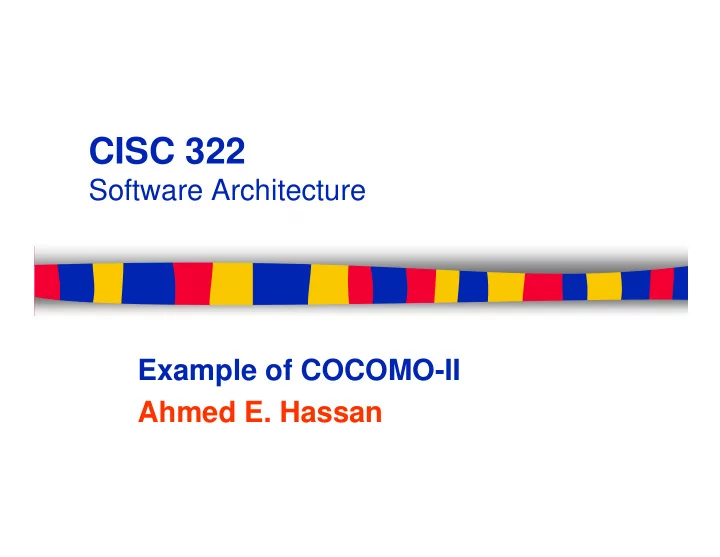

CISC 322 Software Architecture Example of COCOMO-II Ahmed E. Hassan
Function Point Table Number of FPs Complexity External user type Low Average High External input type 3 4 6 External output type 4 5 7 Logical internal file type 7 10 15 External interface file type 5 7 10 External inquiry type 3 4 6
Example of FPA � An inventory system that needs to – ‘Add a record’ – ‘Delete a record’, – ‘Display a record’, – ‘Edit a record’, and – ‘Print a record’ – will have • 3 external input types • 1 external output type • 1 external inquiry type
Object Point Analysis - Screen Number and source of data tables Total < 4 Total < 8 Total 8+ Number of views views (<2 server, (<2 server, (2-3 server, (2-3 server, (>3 server, (>3 server, contained <2 client) 3-5 client) >5 client) < 3 Simple Simple Medium 3 – 7 Simple Medium Difficult 8+ Medium Difficult Difficult
Object Point Analysis - Reports Number and source of data tables Total < 4 Total < 8 Total 8+ Number of sections sections (<2 server, (<2 server, (2-3 server, (2-3 server, (>3 server, (>3 server, contained <2 client) 3-5 client) >5 client) < 2 Simple Simple Medium 2 or 3 Simple Medium Difficult > 3 Medium Difficult Difficult
Object Point Analysis – Complexity Weighting Complexity Type of object Simple Medium Difficult Screen 1 2 3 Report 2 5 8 3GL N/A N/A 10 component
Object Point Analysis – Productivity Rate Very Very Low Nominal High low High Developer’s Developer’s experience 4 7 13 25 50 and capability CASE maturity 4 7 13 25 50 and capability
COCOMO II Effort = Constant × (Size) scale factor × Effort Multiplier – Effort in terms of person-months – Constant: 2.45 in 1998 – Constant: 2.45 in 1998 – Size: Estimated Size in KLOC – Scale Factor: combined process factors – Effort Multiplier (EM): combined effort factors
System to be built � An airline sales system is to be built in C: – Back-end database server has already been built. � We will use object point estimation � We will use object point estimation technique for high level estimates and FP for detailed estimates
Object Point Analysis � Application will have 3 screens and will produce 1 report: – A booking screen: records a new sale booking – A pricing screen: shows the rate for each day – A pricing screen: shows the rate for each day and each flight – An availability screen: shows available flights – A sales report: shows total sale figures for the month and year, and compares figures with previous months and years
Rating of system � Booking screen: – Needs 3 data tables (customer info, customer history table, available seats) – Only 1 view of the screen is enough. So, the – Only 1 view of the screen is enough. So, the booking screen is classified as simple. � Similarly, the levels of difficulty of the pricing screen, the availability screen and the sales report are classified as simple, simple and medium, respectively. There is no 3GL component.
Rating Results Name Objects Complexity Weight Booking Screen Simple 1 Pricing Screen Simple 1 Availability Screen Medium 2 Sales Sales Report Report Medium Medium 5 5 Total 9 � Assessment of the developers and the environment shows: – The developers’ experience is very low (4) – The CASE tool is low (7). So, we have a productivity rate of 5.5. � According to COCOMO II, the project requires approx. 1.64 (= 9/5.5) person-months.
Function Point Estimation (FP->KLOC) Name External user types Complexity FP Booking External output type Low 4 Pricing Pricing External inquiry type External inquiry type Low Low 3 3 Availability External inquiry type Medium 4 Sales External output type Medium 5 Total 16
FP->LOC � Total function points = 16 � Published figures for C show that: – 1 FP = 128 LOC in C � Estimated Size – 16 * 128 = 2048 = 2 KLOC
Scale Factor Estimation Assessme Value Name Very low Low Nominal High Very Extra (0.05) (0.04) (0.03) (0.02) High High nt (0.01) (0.00) Precedentedn Thoroughly Largely Somewhat Generally Largely Thorough Very 0.01 ess unprecedent unprecedent unprecedent familiar familiar ly high ed ed ed familiar Flexibility Flexibility Rigorous Rigorous Occasional Occasional Some Some General General Some Some General General Very Very 0.01 0.01 high relaxation relaxation conformit conformit goals y y Significant Little (20%) Some (40%) Often (60%) Generally Mostly Full Nominal 0.03 risks (75%) (90%) (100%) eliminated Team Very Some Basically Largely Highly Seamless High 0.02 interaction difficult difficult cooperative cooperati cooperati interactio process ve ve ns Low 0.04 Process Level 1 Level 2 Level 2+ Level 3 Level 4 Level 5 maturity Add 1.01 Total 1.13
Effort Adjustment Factors (EAF) Identifier Name Ranges Assessment Values (VL – EH) VL/L/N/H/VH/EH RCPX product Reliability and 0.5 – 1.5 low 0.75 ComPleXity RUSE required reusability 0.5 – 1.5 nominal 1.0 PDIF PDIF Platform DIFficulty Platform DIFficulty 0.5 – 1.5 0.5 – 1.5 high high 1.1 1.1 PERS PERSonnel capability 1.5 – 0.5 high 0.75 PREX PeRsonnel EXperience 1.5 – 0.5 very high 0.65 FCIL FaCILities available 1.5 – 0.5 nomial 1.0 SCED SChEDule pressure 1.5 – 0.5 low 1.2 Product 0.4826 � Effort = 2.45 × (2.048) 1.13 × 0.4826 = 2.66 person-months
References � Hughes, B., and Cotterell, M. (1999) Software project management , 2 nd ed., McGraw Hill � Pfleeger, S.L. (1998) Software Engineering: Theory and Practice , Prentice Hall Theory and Practice , Prentice Hall � Royce, W. (1998) Software Project Management: A Unified Framework , Addison Wesley � Center for Software Engineering, USC (1999) COCOMO II Model Definition Manual .
Recommend
More recommend